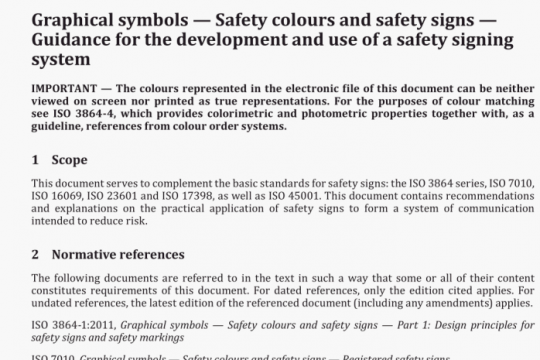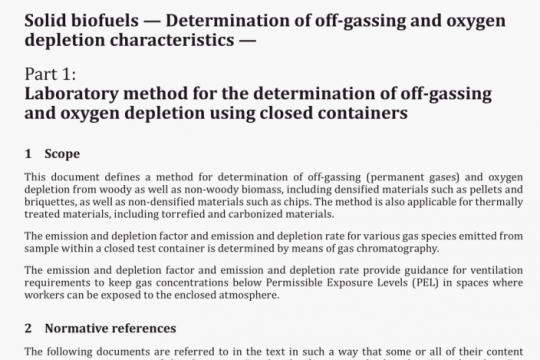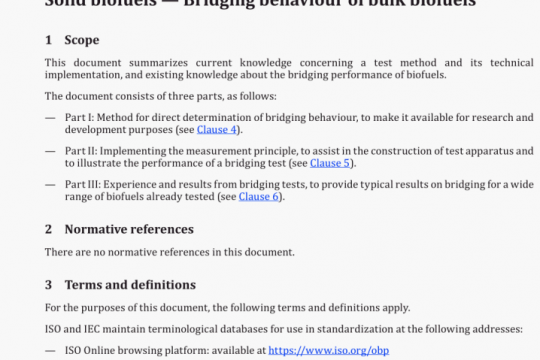ISO 24068-2 pdf free download
ISO 24068-2-2021 pdf free download.Building and civil engineering seal lants – Determination of the degree of cure一 Part 2: Build-up of tensile and adhesion properties in test joint specimens.
6 Preparation of test specimen
The sealant in its unopened package, the substrate pieces, and the spacers shall be conditioned at (23 ± °C and (50 ± 10) % relative humidity for a minimum of 16 h prior to the preparation of the test specimens.
For each substrate type, each cure interval, and the reference cure (method A or B, see 7.2.2. 72.3 and Clause 8), three test specimens shall be prepared. Thus, a minimum of six test specimens are needed for the test (assuming the experimenter choses one substrate, one cure interval and one reference cure for the testing).
For multi-component sealants, the instructions of the sealant manufacturer regarding the mixing procedure shall be followed. One-component sealants can be applied directly from the original container.
For each test specimen, two substrate pieces (5.1) and two spacers (52) shall be assembled in accordance with Iso 8339 and set on the anti-adherent substrate (5,3). Follow the instructions of the sealant manufacturer whether a primer is to be used.
Fill the volume between the substrate supports and spacers with sealant. The following precautions shall be taken:
a) ensure that no air pockets are entrapped in the sealant by filling the test joint cavity from the bottom; b) ensure that no leaks occur at the bottom of the test joint specimen;
c) trim the sealant surface so that it is flush with the faces of the substrate supports and spacers.
The test specimens shall be set on the edge of one of the supports. The anti-adherent substrate shall be removed as soon as possible. The specimens shall be placed in this position to allow curing or optimum drying of the sealant. The spacers shall be maintained in place during conditioning.
7 Conditioning of test and reference specimens
7.1 Conditioning of test specimens
The test specimens shall be conditioned (cured) for a specified period of time (cure interval) at standard conditions of (23 ± °C and (50 ± 10) % relative humidity. One or several arbitrary cure intervals may be selected, as agreed by the parties concerned. Typically, cure intervals are selected from the following: 16 h, 24 h, 48 h, 72 h, 4 d (96 h), 7 d (168 h), 14 d (336 h).
7.2 Conditioning of reference specimens
7.2.1 General
The three reference specimens shall be conditioned either in accordance with method A (see 722) or method B (see 723), or any other reference cure period or conditions (method C: custom) as agreed by the parties concerned.
7.2.2 Method A
The reference specimens shall be conditioned for 28 d at (23 ± °C and (50 ± 10) % relative humidity.
7.2.3 Method B
The reference specimens shall be conditioned according to method A and shall then be subjected three times to the following storage cycle:
a) 3dintheoven(5.5)at(70± °C;
b) 1 d in distilled water (5.6) at (23 ± °C;
c) 2dintheoven(5,5)at(70± °C;
d) 1 d in distilled water (5.6) at (23 ± °C.
Alternatively, this cycle may be carried out in the order c), d), a), b).
After conditioning according to method B. the test specimens shall be stored for 24 h at (23 ± °C and (50 ± 10) % relative humidity before testing.
NOTE Method B is a normal conditioning procedure using the influence of heat and water. It is not suitable forgiving information on the durability of the sealant.
8 Test procedure
The test procedure shall be carried out at standard conditions o1 (23 ± C and (50 ± 10) % relative humidity. A minimum of three test and three reference specimens shall be tested.
At any time when the degree of cure needs to be determined (after the selected cure interval), remove the spacers of the test and reference specimens, place them in the tensile testing machine and extend them at a rate of (5,5 ± 0,5) mm/mm until rupture occurs.
Exercise care when removing the spacers for slow curing sealants as even minor induced movements can affect the test results.
For each test and reference specimen, the stress-strain diagram as well as the values of tensile stress (secant modulus) at the chosen elongation (100 % or 60 %, or any other elongation as decided by the parties concerned), tensile strength (maximum tensile stress), and the type of failure (adhesive or cohesive) shall be recorded.
In the same manner, the reference test specimens shall be tested after completing conditioning method A or B, or any other reference cure period or conditions as agreed by the parties concerned.ISO 24068-2 pdf download.




